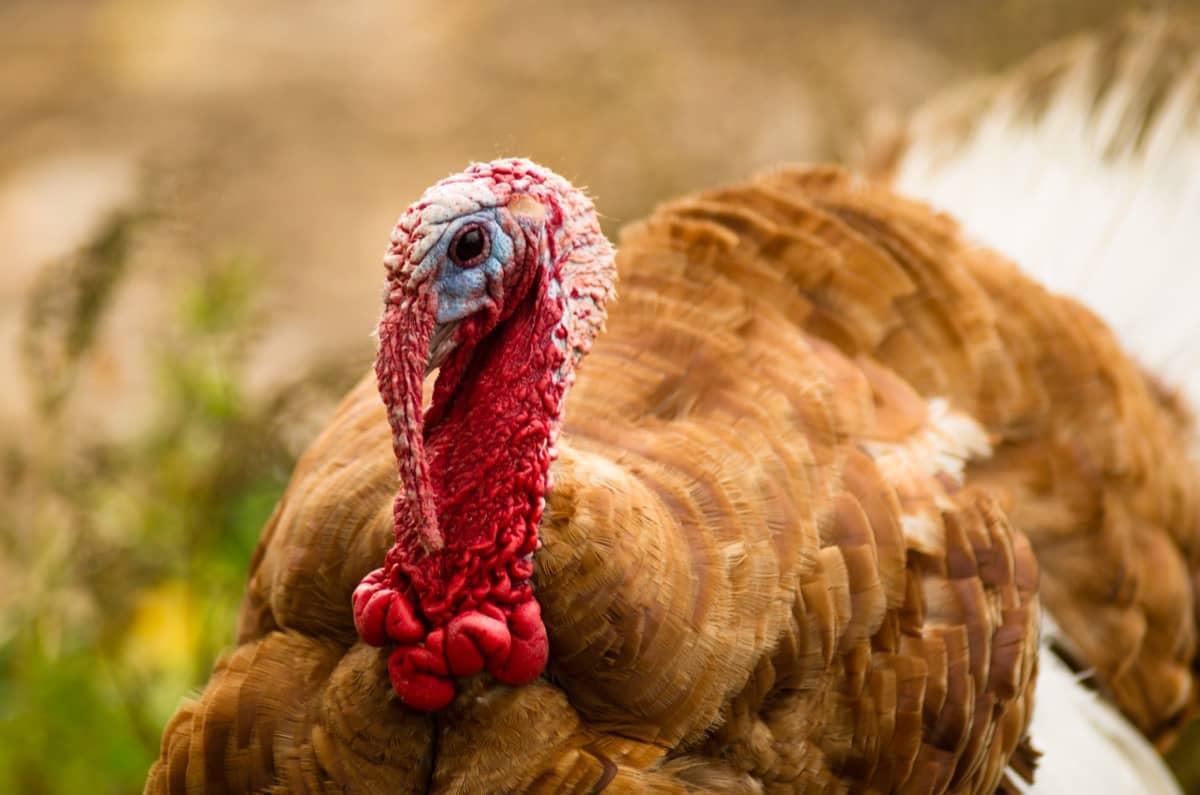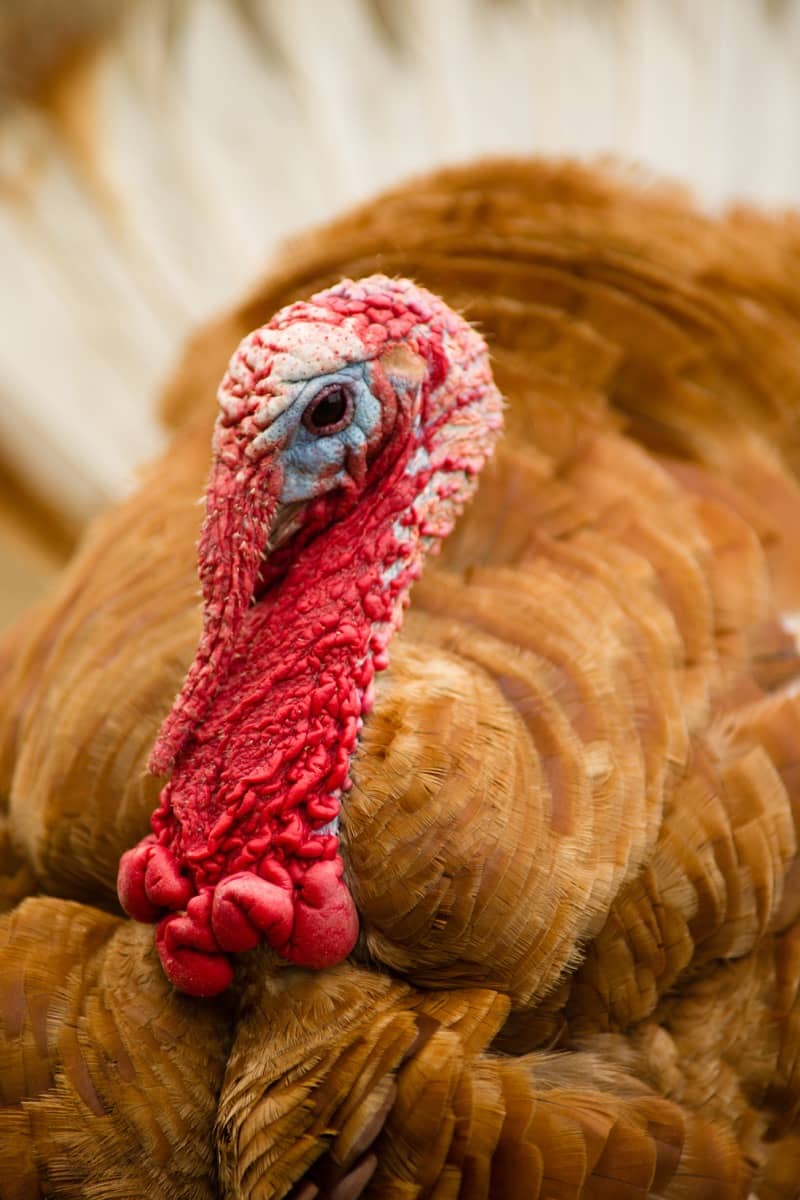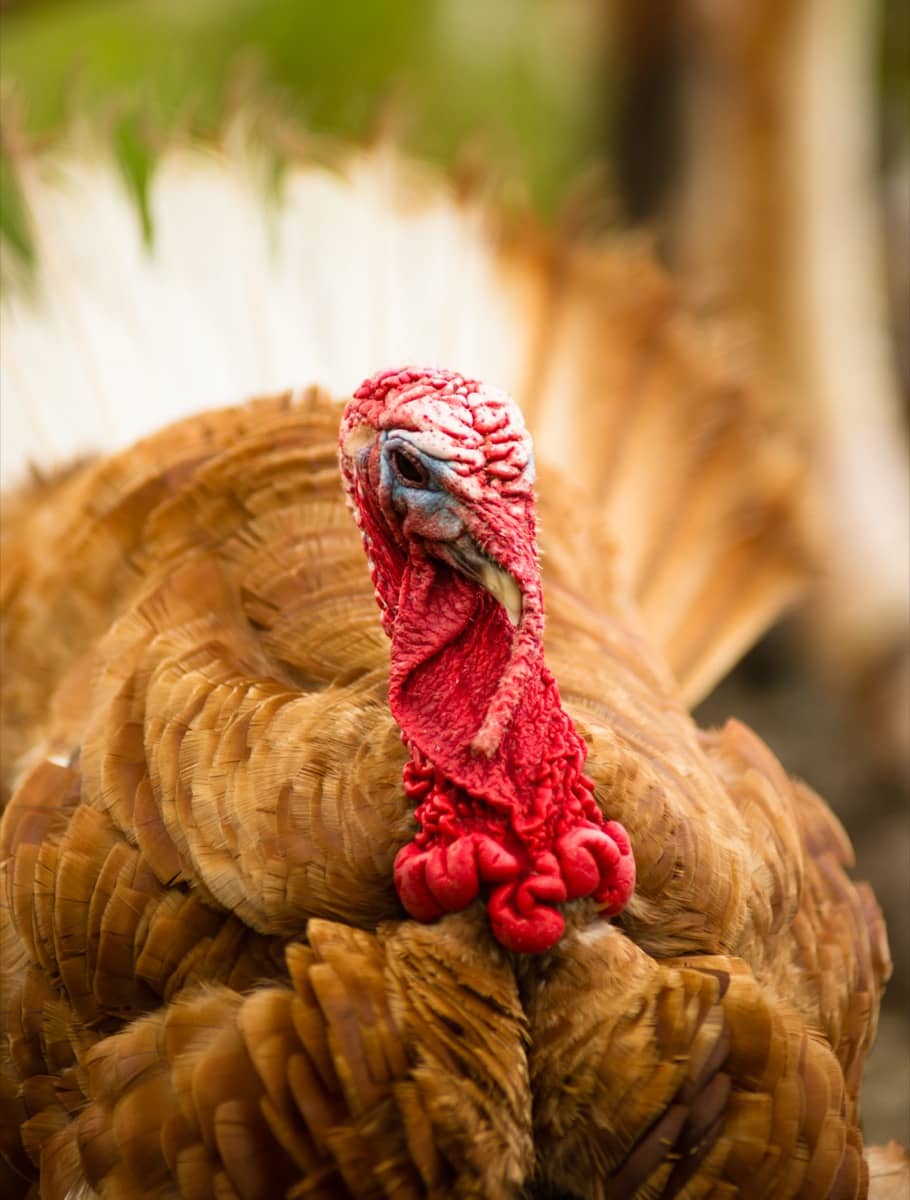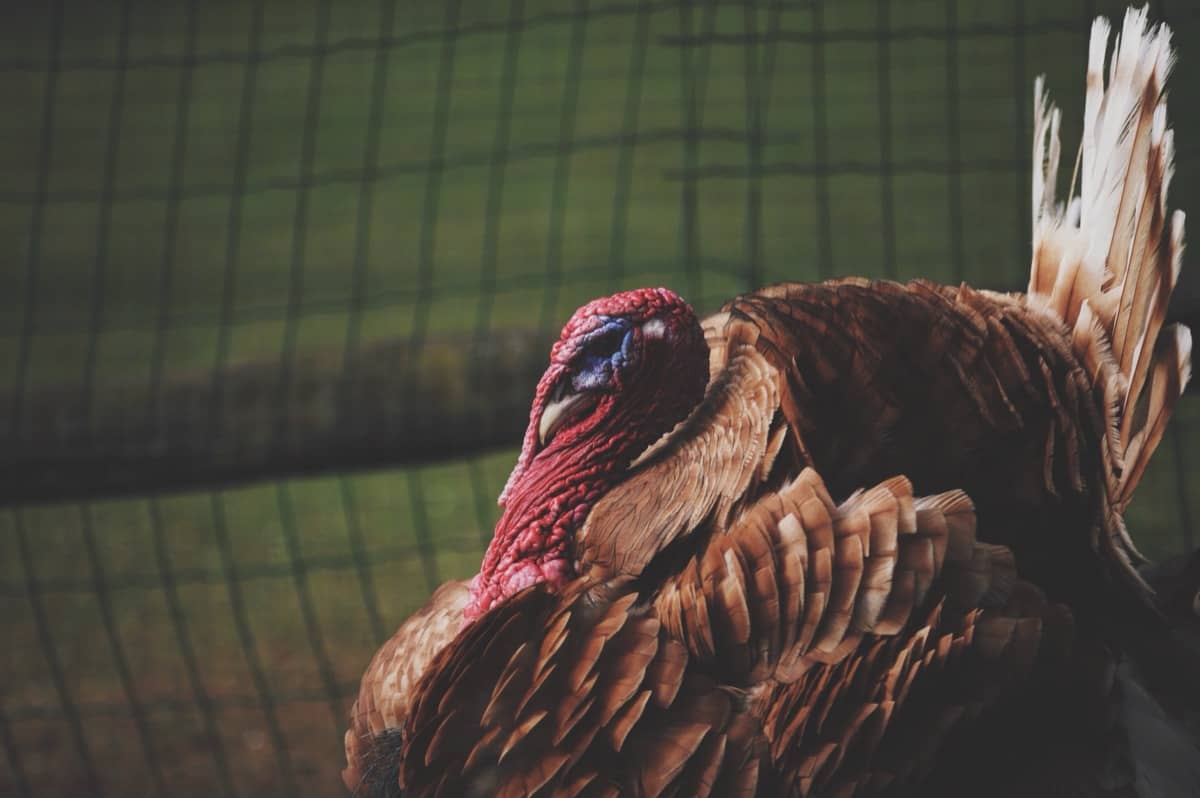The Bourbon Red turkey breed, originating in Kentucky in the late 19th century, is renowned for its striking mahogany plumage and superior meat quality. Characterized by its robust size and docile Bourbon Red Turkey temperament, this heritage breed has become a favorite among small-scale farmers and backyard enthusiasts alike. Notable for its excellent foraging abilities and adaptability to various climates, the Bourbon Red continues to thrive as a cherished breed in the realm of sustainable agriculture. They have a lifespan of around 7-10 years.

All You Need to Know About Bourbon Red Turkey
The Significance of the Bourbon Red in Poultry Breeding
The Bourbon Red turkey holds a significant place in the realm of poultry breeding due to its rich history and versatile attributes. Renowned for its flavorful meat and impressive size, it played a crucial role in diversifying poultry breeds and contributing to the preservation of heritage livestock. Additionally, its adaptability to free-range environments and gentle demeanor make raising Bourbon Red Turkeys an ideal choice for sustainable farming practices, further solidifying its importance in modern poultry breeding initiatives.
Historical Background of Bourbon Red Turkeys
Evolution and Development of the Bourbon Red Breed
History of Bourbon Red turkeys traces its roots to the 19th century in Bourbon County, Kentucky, where it was selectively bred from a combination of Bronze, Buff, and White turkey varieties. Developed for both meat and exhibition purposes, this breed quickly gained popularity for its striking appearance and flavorful meat. Through careful breeding practices, the Bourbon Red evolved into the distinct heritage breed recognized today, prized for its unique coloring and robust constitution.
Historical Importance in American Agriculture
Throughout American agricultural history, Bourbon Red turkeys have held a significant role as a versatile and resilient breed. Their adaptation to various environments and superior meat quality made them a valuable asset to farmers across the country, particularly during the early 20th century. As industrial farming practices evolved, the Bourbon Red-faced declined in commercial popularity but found renewed appreciation among small-scale producers and heritage breed enthusiasts, preserving its historical significance in modern agriculture.
Physical Characteristics of Bourbon Red Turkeys
Description of Their Distinctive Reddish-Brown Feathers
The Bourbon Red turkey is distinguished by its vibrant reddish-brown feathers, which exhibit a lustrous sheen under sunlight. These feathers often feature subtle black banding and white wingtips, adding to their visual appeal. Their plumage extends across their entire body, including the tail and wings, creating a uniform and striking appearance.
Size and Weight Standards for Males and Females
In terms of size, mature Bourbon Red males typically weigh between 11 to 13 kilograms, while females range from 5 to 6 kilograms. Both genders boast broad chests, sturdy legs, and a well-proportioned body, reflecting their heritage as dual-purpose birds prized for both meat and exhibition.
Behavioral Traits and Temperament
Social Behavior and Interaction with Humans
Bourbon Red turkeys are known for their sociable nature and friendly disposition towards humans. They exhibit curious behavior, often following their caretakers around the farmyard and eagerly engaging in interactions. This breed demonstrates a remarkable level of intelligence. They can form strong bonds with their human counterparts, making them enjoyable and manageable to raise, particularly in small-scale or backyard settings.
In case you missed it: Broad Breasted Bronze Turkey: Characteristics, Origin, Size, Uses, Price, Breeding, and Lifespan

Adaptability to Various Farming Environments
Renowned for their adaptability, Bourbon Red turkeys thrive in various farming environments, from free-range pastures to more confined spaces. They possess excellent foraging skills, actively seeking out insects, seeds, and greens, which contribute to their overall health and well-being. Additionally, their hardy constitution enables them to withstand fluctuations in temperature and environmental conditions.
Bourbon Red Size and Weight and Growth Rate
Average Size Comparison with Other Turkey Breeds
Compared to other turkey breeds, Bourbon Reds typically reach slightly smaller sizes. The Bourbon Red turkey growth rate can vary based on factors like genetics, diet, environmental conditions, and management practices. Mature Bourbon Red toms generally weigh around 11 to 13 kilograms, with hens ranging from 5 to 6 kilograms. Despite their slightly smaller stature, Bourbon Reds are valued for their excellent meat quality and flavor.
Growth Milestones and Meat Production Qualities
Bourbon Red Turkeys exhibit a moderate growth rate, taking approximately 5 to 6 months to reach market weight. During this period, they efficiently convert feed into muscle, resulting in well-developed breasts and thighs prized for their flavorful, tender meat. This breed’s balanced growth and meat production qualities make it a popular choice among small-scale farmers and backyard enthusiasts seeking high-quality, homegrown poultry products.
Dietary Requirements and Nutrition
Feeding Strategies for Optimal Health and Growth
Feeding Bourbon Red Turkeys involves a balanced diet consisting of high-quality turkey feed supplemented with fresh greens, grains, and protein sources such as insects or mealworms. Providing access to clean water at all times is essential. Also, offering grit aids in digestion, while occasional treats like fruits or vegetables can provide enrichment. Monitoring feed consumption and adjusting rations based on age and activity level.
Nutritional Needs Throughout Different Life Stages
Nutritional needs of Bourbon Reds involve young poults requiring starter feed with higher protein levels (around 28-30%) for rapid growth and development. As they mature, transitioning to grower and finisher feeds with slightly lower protein content (around 18-20%) supports steady growth while avoiding excess fat deposition. Laying hens benefit from calcium-rich layer feed to support egg production, supplemented with oyster shells for shell strength.
Habitat and Housing Needs
Bourbon Red Housing Needs
Bourbon Red turkeys thrive in spacious, well-ventilated living conditions that protect them from predators and adverse weather conditions. A minimum of 4-5 square feet of indoor space per bird is recommended, with ample outdoor access for foraging and exercise. Utilizing sturdy fencing to enclose a range area prevents escapes and protects birds from potential threats.
Tips for Constructing Suitable Shelters and Ranges
Use materials like wood or metal for housing structures, ensuring adequate ventilation and protection from drafts. Incorporate roosts at varying heights to accommodate birds’ preferences for perching. Outdoor ranges should be securely fenced to prevent predator intrusion, with access to shade and shelter. Regularly maintaining clean bedding and monitoring for signs of stress or illness promotes a healthy living environment for these birds.
Health and Welfare Management
Common Health Issues and Preventative Measures
Bourbon Red turkeys are generally hardy birds, but they can be susceptible to common poultry ailments such as respiratory infections, parasites, and nutritional deficiencies. Regular monitoring for signs of illness, proper sanitation practices, and providing balanced nutrition are essential health management for Bourbon Reds. Vaccinations for diseases like Marek’s and Newcastle can also help safeguard the flock’s health.
Best Practices for Maintaining a Healthy Flock
Maintaining a healthy flock of Bourbon Red turkeys involves implementing rigorous biosecurity measures, including limiting exposure to wild birds and disinfecting equipment and footwear. Providing clean water, a balanced diet, and appropriate shelter are fundamental. Regular health checks, prompt treatment of any illnesses or injuries, and maintaining optimal living conditions contribute to the well-being and longevity of the flock. Regular communication with a veterinarian can also provide valuable guidance for managing the flock’s health.
Breeding and Reproduction
Selective Breeding Techniques for Quality Offspring
Selective breeding of Bourbon Red Turkey plays a crucial role in producing high-quality Bourbon Red turkey offspring. Breeders carefully choose individuals with desirable traits such as size, plumage color, and temperament for mating. By selectively pairing birds over multiple generations, breeders can improve characteristics while maintaining breed standards.
In case you missed it: Top 10 Turkey Breeds for Meat: Discover Best Tasting Turkey Breed

Managing the Breeding Cycle and Hatchling Care
Managing the Bourbon Red Turkey breeding cycle involves monitoring hens for signs of readiness to lay eggs and ensuring proper nesting conditions. Incubating eggs or allowing hens to brood naturally contributes to successful hatchings. After hatching, providing warmth, nutrition, and protection from predators is essential for the health and development of poults.
Market Value and Price Range
Factors Influencing Bourbon Red Turkey Prices
Several factors influence the market value of Bourbon Red turkeys, including demand for heritage breeds, the quality of individual birds, and seasonal fluctuations in supply. Additionally, factors such as location, breeder reputation, and certifications for organic or pasture-raised practices can impact prices. An adult Bourbon Red Turkey price ranges from $120 to $150.
Economic Considerations for Breeders and Farmers
Breeders and farmers must consider various economic factors when raising Bourbon Red turkeys, including the cost of feed, housing, veterinary care, and marketing expenses. Balancing these costs with potential revenue from meat sales, breeding stock, or exhibition birds is essential for profitability.
In case you missed it: Norfolk Black Turkey Breed: Characteristics, Origin, Size, Uses, Price, Breeding, and Lifespan

Conclusion
The Bourbon Red turkey breed stands as a testament to the rich heritage and enduring appeal of heritage poultry. With its striking appearance, versatile qualities, and flavorful meat, it continues to capture the hearts of farmers, enthusiasts, and consumers alike. From its humble origins to its place in modern agriculture, the Bourbon Red remains a cherished breed, embodying the timeless charm of traditional farming practices.
- Feed Your Flock for Less: Top 10 Tips to Save on Chicken Feed
- Ultimate Guide to Ossabaw Island Hog: Breeding, Raising, Diet, and Care
- Hatching Answers: The Top 10 Reasons Your Chickens Aren’t Laying Eggs
- Eggs and Economics: Breaking Down the Cost of Raising Backyard Chickens
- Defend Your Greens: Proven Methods to Keep Iguanas Out of Your Garden
- Ultimate Guide to Cinnamon Queen Chicken: A Comprehensive Guide for Beginners
- Ultimate Guide to California Tan Chicken: Breeding, Raising, Diet, Egg-Production and Care
- Ultimate Guide to Marsh Daisy Chicken: Breeding, Raising, Diet, and Care
- 10 Types of Chicken Farming Businesses You Can Start for Profits